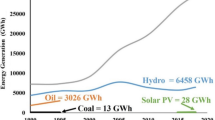Abstract
The reasonable evaluation of the enterprise energy efficiency is an important work in order to reduce the energy consumption. In this paper, an effective energy efficiency evaluation index system is proposed based on DPSR (Driving forces-Pressure-State-Response) with the consideration of the actual situation of enterprises. This index system which covers multi-dimensional indexes of the enterprise energy efficiency can reveal the complete causal chain which includes the “driver forces” and “pressure” of the enterprise energy efficiency “state” caused by the internal and external environment, and the ultimate enterprise energy-saving “response” measures. Furthermore, the ANP (Analytic Network Process) and cloud model are used to calculate the weight of each index and evaluate the energy efficiency level. The analysis of BL Company verifies the feasibility of this index system and also provides an effective way to improve the energy efficiency at last.















Similar content being viewed by others
References
Bosseboeuf D, Chateau B, Lapillonne B (1997) Cross country comparison on energy efficiency indicators: the on-going European effort towards a common methodology. Energy Policy 25(9):673–682
Besikci EB, Kececi T, Arslan O, Turan O (2016) An application of fuzzy-AHP to ship operational energy efficiency measures. Ocean Eng 121:392–402
Chen YW, Mu J, Ma JG, Liu B, Yu JQ (2008) Study on the energy efficiency indicator system and evaluation model in the oil-gas fields. Petroleum Planning & Engineering 3:147–148
Ergu D, Kou G, Peng Y, Shi Y, Shi Y (2013) The analytic hierarchy process: task scheduling and resource allocation in cloud computing environment. J Supercomput 2013:643
Ge B (2014) Research on evaluation and model establishment of the energy consumption in the process of fiberboard manufacturing. Dissertation, Northeast Forestry University
Gupta M, Narain R (2015) A fuzzy ANP based approach in the selection of the best E-business strategy and to assess the impact of E-procurement on organizational performance. Inf Technol Manag 16(4):339–349
Hao HB, Lu YL, Song XL (2015) Construction of energy efficiency evaluation index system of a mechanical enterprise. Energy Conservation 2:16–18
Iskin I, Daim TU (2016) An assessment model for energy efficiency program planning in electric utilities: case of northwest U.S. Sustainable Energy Technologies and Assessments 15:42–59
Jharkharia S, Shankar R (2007) Selection of logistics service provider: ananalytic network process (ANP) approach. Int J Manag Sci 35:274–289
Kohl T, Laukkanen T, Tuomaala M, Niskanen T, Siitonen S, Jarvinen MP, Ahtila P (2014) Comparison of energy efficiency assessment methods: case bio-SNG process. Energy 74:88–98
Liu ZF (2007) Study on establishing evaluation index system of energy utilization efficiency. Energy and Environment 2007:2–4
Lin J (2002) Research on energy efficiency evaluation system of paper making enterprises. Dissertation, Guangxi University
Li SL (2012) Energy efficiency evaluation and energy saving analysis of enterprises. Dissertation, Yanshan University
Mao ZH, Wang Y (2016) Energy efficiency evaluation method of machine tool product manufacturing system based on grey fuzzy algorithm. Computer Systems & Applications 7:1–7
Nouri J, Lotfi FH, Borgheipour H, Atabi F, Sadeghzadeh SM, Moghaddas Z (2013) An analysis of the implementation of energy efficiency measures in the vegetable oil industry of Iran: a data envelopment analysis approach. J Clean Prod 52:84–93
OECD (2003) Organisation for economic co-operation and development (OECD) core set of indicators for environmental performance reviews. France, Paris
Pang HM, Liu ZH (2016) Study on food safety surveillance and risk assessment based on cloud model. J Food Sci Technol 3:90–94
Saaty TL (1996) Decision making with dependence and feedback: the analytic network process, 1st edn. RWS Publications, Pittsburgh
Sun JW, Meristo T (1999) Measurement of dematerialization/materialization: a case analysis of energy saving and decarbonization in OECD countries, 1960–95. Technol Forecast Soc 60(3):275–294
Sardian E (2008) Barriers to industrial energy efficiency investments in Greece. J Clean Prod 16:1416–1423
Samuel VB, Agamuthu P, Hashim MA (2013) Indicators for assessment of sustainable production: a case study of the petrochemical industry in Malaysia. Ecol Indic 24:392–402
Unver S, Gurbuz T (2015) Threat evaluation using analytic network process. Ifac Papersonline 48(3):8–13
WEC (2006) Wec statement 2006: energy efficiencies: pipe-dream or reality? Presented at the world energy council (WEC). UK, London
Wang ZH, Zeng HL, Wei YM, Zhang YX (2012) Regional total factor energy efficiency: an empirical analysis of industrial sector in China. Appl Energ 97:115–123
Wang HZ, Liu K, Zhu HY (2016) Load forecasting of power system based on cloud model and support vector machine with RBF. Journal of Lanzhou University of Technology 4:1–4
Xu YX, Wang HY (2016) Evaluation of airport service quality cloud model based on AHP-entropy weight method. Value Engineering 2:7–10
Yuan J (2013) Study on our oil companies of energy efficiency benchmarking system and energy efficiency evaluation. Dissertation, Northeast Petroleum University
Yang Y (2010) Study on evaluation for energy conservation and emission. Dissertation, Wuhan University of Technology
Zhang R (2012) Study on monitoring and evaluation method of energy consumption index of railway transportation enterprises. Dissertation, Southwest Jiaotong University
Author information
Authors and Affiliations
Corresponding author
Additional information
Responsible editor: Philippe Garrigues
Appendix
Appendix
Rights and permissions
About this article
Cite this article
Wei, JY., Zhao, XY. & Sun, XS. The evaluation model of the enterprise energy efficiency based on DPSR. Environ Sci Pollut Res 26, 16835–16846 (2019). https://doi.org/10.1007/s11356-017-9096-0
Received:
Accepted:
Published:
Issue Date:
DOI: https://doi.org/10.1007/s11356-017-9096-0








